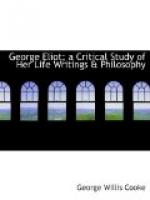It is not necessary here to enter into a full presentation of Lewes’s philosophy, but his theories about the functions of feeling are of importance, in view of George Eliot’s acceptance of them. They have been summarized into the statement that “all truths are alike feelings, ideally distinguishable according to the aspects under which they are viewed. There is no motion apart from feeling, for the motion is the feeling; there is no force apart from matter which compels it to moves for the force is the matter, as matter is motion—differently viewed; there is no essence or substance which determines the properties, for the substance is the whole group of properties; there are no causes outside of effects, no laws outside the processes, no reality outside the phenomena, no absolute outside the relative, which determine things to be as they are and not otherwise, for all these are but different sides of one and the same thing.” The central thought presented by Lewes is, that “for us there is nothing but feeling, whose subjective side is sensations, perceptions, memories, reasonings, the ideal constructions of science and philosophy, emotions, pleasures, pains; whose objective side is motion, matter, force, cause, the absolute.” The outcome of this theory is, it enables Lewes to believe that the inner and outer practically agree, that our feelings give a sufficiently correct picture of the universe. In reality, the two do not agree, and even “science is in no respect a plain transcript of reality;” but so intimate are feeling and the outer world, that the inward report is to be regarded as practically a correct one.
In many ways Lewes differed from his contemporaries, disagreeing again and again with Spencer, Bain and Huxley. He often seems much nearer Schelling than Haeckel. He differs from Schelling in his demand for verification and the inductive method, and in claiming that all his conclusions are the result of scientific experiments and deductions. He agrees with Schelling in his rejection of mechanical processes and in his acceptance of a vital, organic method in nature and in social development. He differs from many of the other leaders of speculative science in his rejection of reflex action, maintaining that the brain is not the only seat of sensation, and that all cerebral processes are mental processes. With equal vigor he rejects the theory of animal automatism,




